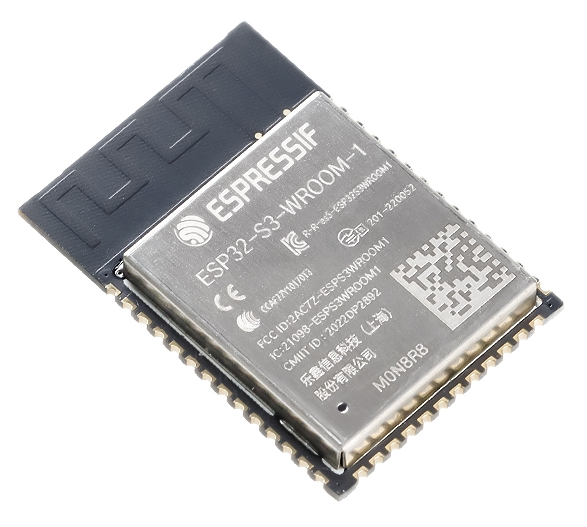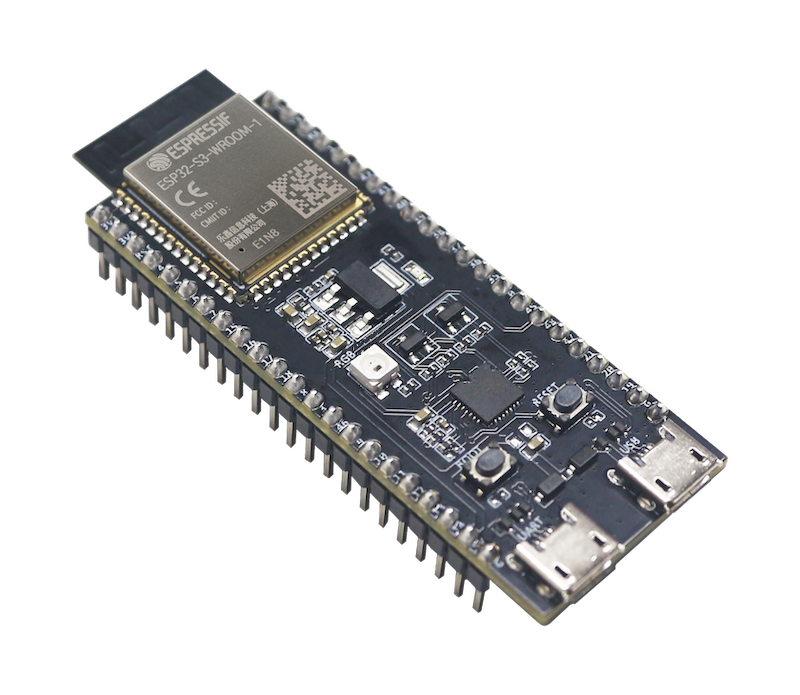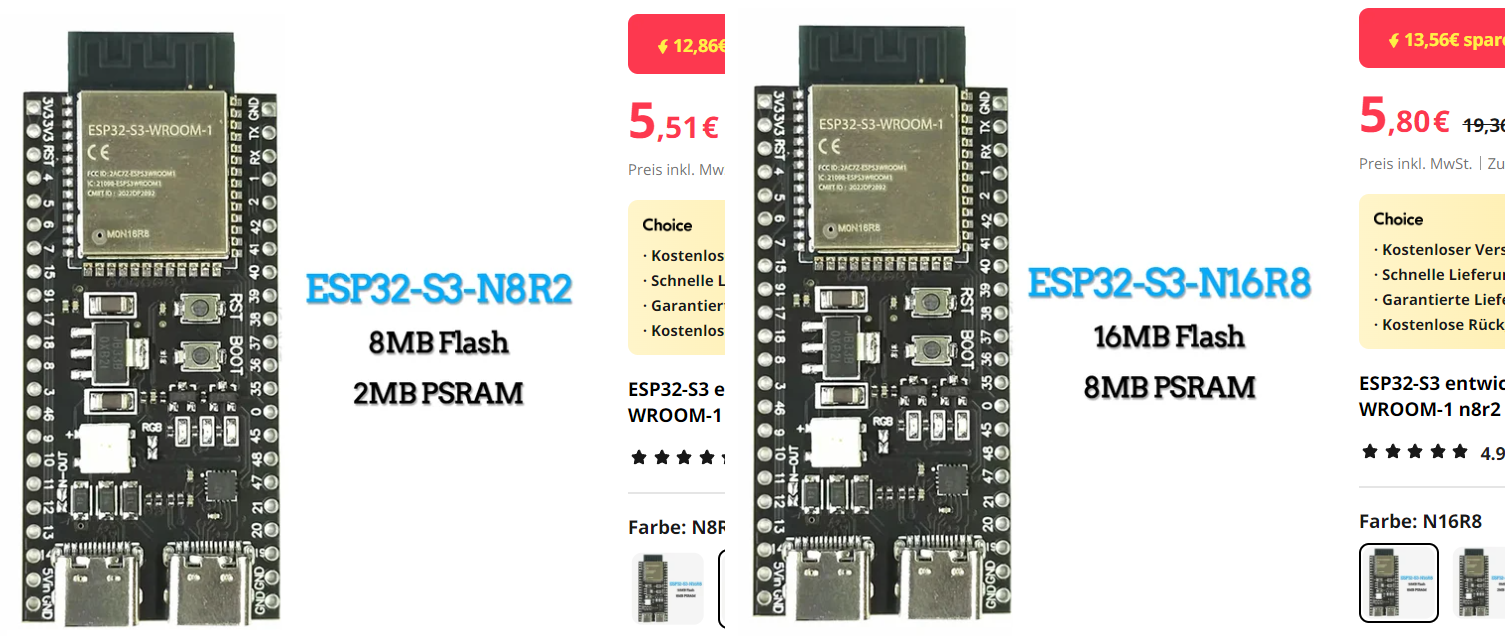Selecting a Board
TL;DR
If you are interested in wiring up the hardware yourself instead of using an
integrated solution, acquire an ESP32-S3
DevKit Board with a N16R2 type of module.
Definitions and Background
- There are variants of the ESP32 series other than
ESP32andESP32-S3. OpenDTU-OnBattery is mostly concerned with the aforementioned two types.  Chip or MCU or SoC: Refers to the ESP32(-S3) silicon chip in a
plastic package without any PCB or external components.
Chip or MCU or SoC: Refers to the ESP32(-S3) silicon chip in a
plastic package without any PCB or external components.- This part determines whether you are using an
ESP32or anESP32-S3. - Example part numbers:
ESP32-U4WDH,ESP32-S3,ESP32-S3R2, orESP32-S3FH4R2. - Some chips have integrated flash and/or PSRAM, while others do not.
- Details can be found in the ESP32 datasheet, ESP32-S3 datasheet, or even the ESP32-S3 Technical Reference Manual.
- These parts are manufactured by Espressif.
- A popular consumer product integrating these chips directly are Shelly devices.
- This part determines whether you are using an
 Module: Refers to an assembled part consisting of an ESP32(-S3) chip and
external components, soldered onto a PCB, and hidden under an RF shield.
Module: Refers to an assembled part consisting of an ESP32(-S3) chip and
external components, soldered onto a PCB, and hidden under an RF shield.- Example part numbers:
ESP32-WROOM-32U,ESP32-S3-WROOM-1-N4, orESP32-S3-WROOM-2-N16R8V. - Many modules add SPI flash memory and/or PSRAM, which are external to the SoC.
- Details can be found in the respective datasheets (non-exhaustive list): ESP32-WROOM-32, ESP32-WROOM-32D/U, ESP32-S3-WROOM-1, or ESP32-S3-WROOM-2.
- These modules are originally manufactured by Espressif, but there are compatible knock-off products advertised under identical part numbers.
- Using these modules simplifies integration into custom applications. Popular consumer products using these modules are ESP32-based relay boards.
- Example part numbers:
 Board or PCB: Refers to the PCB which integrates an ESP32(-S3) module
with a power supply, USB connector(s), pin headers, and more components to
facilitate practical use of the module.
Board or PCB: Refers to the PCB which integrates an ESP32(-S3) module
with a power supply, USB connector(s), pin headers, and more components to
facilitate practical use of the module.- Example parts:
ESP32-DevKitC,ESP32-S3-DevKitC-1, OpenDTU Fusion. - Espressif originally manufactured the aforementioned development kits, which became a de facto standard for hobbyists. Third party manufacturers sell compatible boards using identical names.
- Example parts:
Flash Memory
Due to the growing size of the firmware binaries, an ESP32 module with at least 8 MB of flash memory is required to be able to use OTA updates. You may run OpenDTU-OnBattery on ESP32-based boards with only 4 MB of flash memory, but you will have to update the firmware on these boards using the USB connection, i.e., physical access is required.
ESP32 vs. ESP32-S3
You should prefer an ESP32-S3 (note the "S3"). The ESP32-S3 has more GPIOs (not all may be pinned out) and a slightly more efficient core. More importantly, it has native USB support, freeing one hardware UART.
ESP32-S3 Board
ESP32-S3 Reserved Pins
ESP32-S3 modules with 8 MB of PSRAM use an octal SPI interface. On these modules, pins GPIO 35, 36, and 37, which are usually wired to the board's pin header, are in use for the internal communication between ESP32-S3 and PSRAM. Therefore, these pins are not available for external use, even though they are wired to the board's pin header.
Use a board which integrates one of the following modules:
| ESP32-S3-WROOM-... | Flash | PSRAM | Antenna |
|---|---|---|---|
| ...1U-N16R8 | 16 MB | 8 MB | external |
| ...1-N16R8 | 16 MB | 8 MB | PCB Trace |
| ...1U-N16R2 | 16 MB | 2 MB | external |
| ...1-N16R2 | 16 MB | 2 MB | PCB Trace |
| ...1U-N16 | 16 MB | - | external |
| ...1-N16 | 16 MB | - | PCB Trace |
| ...1U-N8R8 | 8 MB | 8 MB | external |
| ...1-N8R8 | 8 MB | 8 MB | PCB Trace |
| ...1U-N8R2 | 8 MB | 2 MB | external |
| ...1-N8R2 | 8 MB | 2 MB | PCB Trace |
| ...1U-N8 | 8 MB | - | external |
| ...1-N8 | 8 MB | - | PCB Trace |
| ...2-N16R8V | 16 MB | 8 MB | PCB Trace |
| ...2-N32R8V | 32 MB | 8 MB | PCB Trace |
Make sure that the board actually uses the native USB capability, such that the third hardware UART becomes available. There are boards with two USB connectors, where one connects natively to the ESP32. In that case, the board is fine. On board with only one USB connector, look out for a USB to UART transceiver. If there is one on the board, the chip is possibly not connected natively to the USB port.
16 MB of Flash Memory
You will not be able to leverage 16 MB of flash memory with OpenDTU-OnBattery any time soon. However, given the price difference, you might want to go for a version with 16 MB, allowing the module/board to be reused in a different project eventually.
